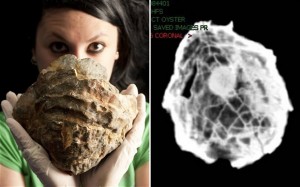A gintic oyster fossil that was trawled up by fisherman has been MRI scanned to reveal what could be a pearl as large as a golf ball.
The mollusk was given to agan aquarium where experts used growth rings to determine how old it was, and were keen to discover if there was a rare gem inside.
The medical charity Cobalt, which provides state of the art scanning services, heard of the prehistoric find and volunteered to scan the oyster.
The scan showed a mysterious smooth object about the size of a golf ball inside the 145-million-year-old shell.If it were removed and identified as a pearl; it could be worth many thousands of pounds. But experts have decided not to explore the contents any further because the oyster would have to be destroyed.The fossil that is about 7ins across, remains at the Blue Reef Aquarium in Portsmouth, Hants, where it is kept securely and brought out for lectures and talks.
Lindsay Holloway, from the aquarium, said: “It was discovered in the nets of a fishing boat which was dredging here in the Solent.
“When the fishermen came back to port they thought it was real, but when they picked it up, cleaned it, and had a closer look they could tell it was a fossil.
“It had completely turned to stone.
“A member of the public called and informed us it was on display at a local fishmongers so we called them and they gave it to us to have in the aquarium.
“Oysters can be aged by annual growth rings on their shells and we have counted more than 200 rings on this oyster making it an extremely long-lived individual.
“It’s obviously a million-to-one chance that it would contain anything but, if you were to go purely on the dimensions of the shell then you’d be looking at a golf ball-sized pearl.”
Geoffrey Munn, the jewellery expert on the Antiques Road show and managing director of the famed London jeweler Wartski, was delighted with news of the find.
He said: “What a wonderful discovery. It sounds like there is every possibility that this is a pearl. I can’t see why not.
“Pearls are not peculiar to oysters and can be found in conches and in our own fresh water mussels.
“Nowadays most pearls are found in far-flung places, but 145 million years ago it’s quite possible that they grew nearer to home.
“To have a pearl the size of a golf ball would be exceptional, and the biggest that have been recorded are about half that size.
“However, if this shell were opened I think the beauty of the pearl would have gone.”
Coutesy: Bournemouth News



 July 26th, 2012
July 26th, 2012  riffin
riffin 
 Posted in
Posted in 